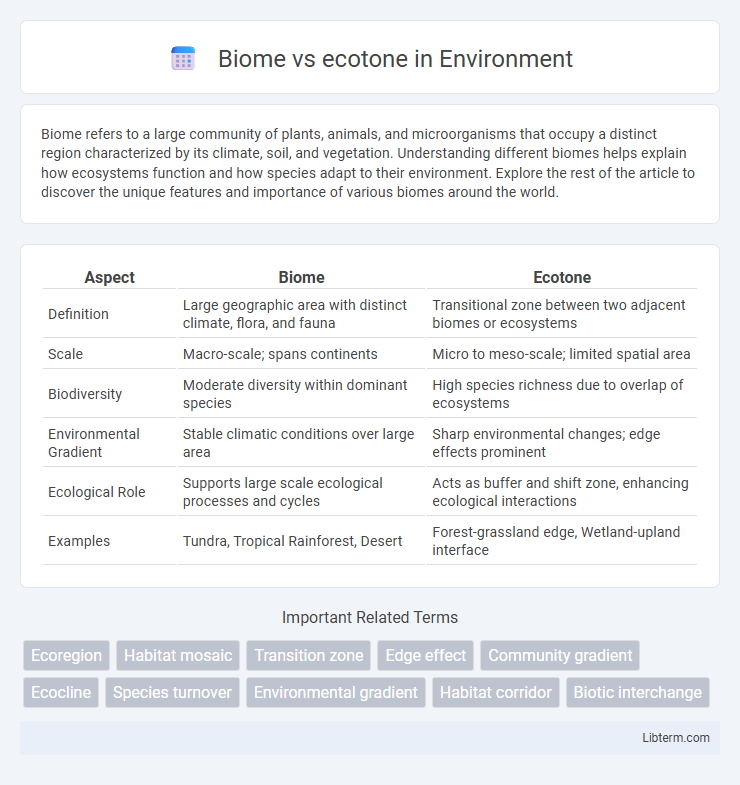Biome refers to a large community of plants, animals, and microorganisms that occupy a distinct region characterized by its climate, soil, and vegetation. Understanding different biomes helps explain how ecosystems function and how species adapt to their environment. Explore the rest of the article to discover the unique features and importance of various biomes around the world.
Table of Comparison
| Aspect | Biome | Ecotone |
|---|---|---|
| Definition | Large geographic area with distinct climate, flora, and fauna | Transitional zone between two adjacent biomes or ecosystems |
| Scale | Macro-scale; spans continents | Micro to meso-scale; limited spatial area |
| Biodiversity | Moderate diversity within dominant species | High species richness due to overlap of ecosystems |
| Environmental Gradient | Stable climatic conditions over large area | Sharp environmental changes; edge effects prominent |
| Ecological Role | Supports large scale ecological processes and cycles | Acts as buffer and shift zone, enhancing ecological interactions |
| Examples | Tundra, Tropical Rainforest, Desert | Forest-grassland edge, Wetland-upland interface |
Understanding Biomes: Definition and Key Features
A biome is a large ecological area characterized by distinct climate conditions, plant communities, and animal species, such as tundras, deserts, or tropical rainforests. Key features of biomes include temperature ranges, precipitation levels, and dominant vegetation types that shape the ecosystem's biodiversity and function. Understanding biomes helps clarify large-scale patterns in Earth's ecology, distinguishing them from ecotones, which are transitional zones where two biomes overlap and exhibit mixed characteristics.
What is an Ecotone? Distinct Characteristics
An ecotone is a transitional zone between two distinct biomes or ecosystems, characterized by a unique blend of species from both adjacent areas, often resulting in higher biodiversity. This boundary area exhibits distinct environmental conditions such as soil type, moisture, and microclimate variations that are intermediate between the neighboring ecosystems. Ecotones also serve as critical habitats for species adapted to edge environments and play a significant role in ecological processes like nutrient cycling and species migration.
Structural Differences: Biome vs Ecotone
Biomes are large-scale ecological units with uniform climatic conditions and dominant vegetation types, such as deserts, forests, or tundras, exhibiting relatively stable and homogeneous structural characteristics. Ecotones, by contrast, are transitional areas between biomes characterized by a mix of species and environmental conditions that produce high structural heterogeneity and edge effects. The structural differences between biomes and ecotones include biome stability and uniformity versus ecotone variability and complexity due to species overlap and dynamic environmental gradients.
Biodiversity Comparison: Biomes and Ecotones
Biomes encompass vast geographic areas characterized by dominant plant and animal communities adapted to similar climate conditions, supporting moderate biodiversity due to broad environmental uniformity. Ecotones, as transitional zones between biomes, exhibit heightened biodiversity by hosting species from adjacent biomes alongside unique organisms adapted to variable conditions. This edge effect in ecotones creates ecological richness surpassing that of individual biomes, making ecotones crucial hotspots for conservation and species interactions.
Ecological Functions of Biomes
Biomes, large-scale ecological units characterized by distinct climate, vegetation, and animal life, perform critical ecological functions such as carbon sequestration, nutrient cycling, and habitat provision that sustain global biodiversity and climate stability. Ecotones, the transition zones between biomes, act as biodiversity hotspots and serve as ecological corridors facilitating species migration and gene flow, thereby enhancing ecosystem resilience and adaptation to environmental changes. The dynamic interactions between biomes and ecotones maintain ecological balance and support ecosystem services essential for human well-being.
The Role of Ecotones in Ecosystem Dynamics
Ecotones serve as transitional zones between distinct biomes, often exhibiting high biodiversity and unique species interactions that influence ecosystem dynamics. These areas facilitate nutrient exchange, migration corridors, and genetic flow, enhancing ecological resilience and adaptability. Understanding ecotones is crucial for managing environmental changes and conserving ecosystem functions across biome boundaries.
Adaptations of Flora and Fauna in Biomes vs Ecotones
Flora and fauna in biomes exhibit specialized adaptations tailored to stable climatic conditions, such as drought-resistant cacti in deserts and thick fur in tundra mammals, enhancing survival within specific environmental parameters. In contrast, ecotones display species with versatile traits, like generalist feeders and adaptable reproductive strategies, enabling them to thrive amid varying microclimates and resource availability where two or more biomes intersect. This dynamic species composition in ecotones promotes high biodiversity and unique ecological interactions not typically found within the more uniform conditions of individual biomes.
Human Impact: Changes in Biomes and Ecotones
Human impact significantly alters both biomes and ecotones through deforestation, urban development, and climate change, causing habitat fragmentation and loss of biodiversity. In biomes, these changes disrupt large-scale ecological processes and species distributions, while ecotones--transitional zones between biomes--face heightened vulnerability due to their sensitivity to microclimatic shifts and edge effects. Conservation efforts must prioritize ecotones to maintain ecosystem connectivity and resilience amid accelerating anthropogenic disturbances.
Conservation Strategies: Protecting Biomes and Ecotones
Conservation strategies for biomes prioritize preserving large-scale ecosystems such as tropical rainforests, deserts, and tundras by maintaining biodiversity and reducing habitat fragmentation. Ecotone conservation targets transitional zones between biomes, which are critical for species migration and genetic exchange, thus enhancing ecosystem resilience. Effective protection involves establishing buffer zones and promoting connectivity corridors to support both biome stability and ecotone integrity.
Biome-Ecotone Interactions and Their Importance
Biome-ecotone interactions represent critical zones where distinct ecological communities converge, leading to increased biodiversity and unique species adaptations. These transitional areas influence ecosystem dynamics by facilitating species migration, genetic exchange, and resilience to environmental changes. Understanding these interactions enhances conservation strategies and helps predict ecological responses to climate change.
Biome Infographic

 libterm.com
libterm.com